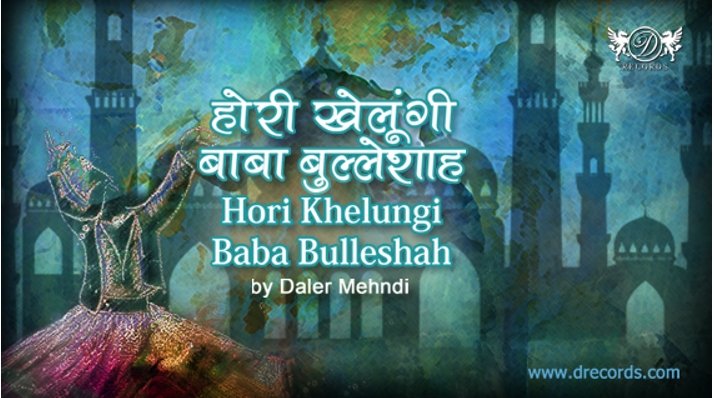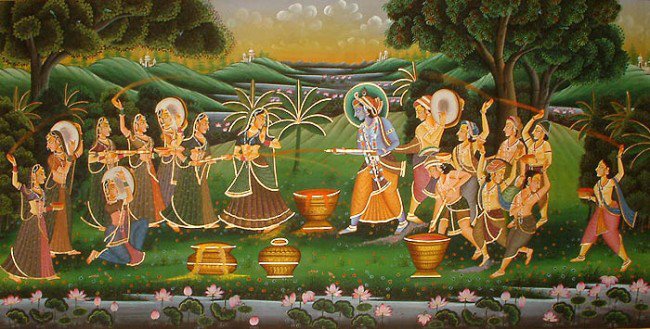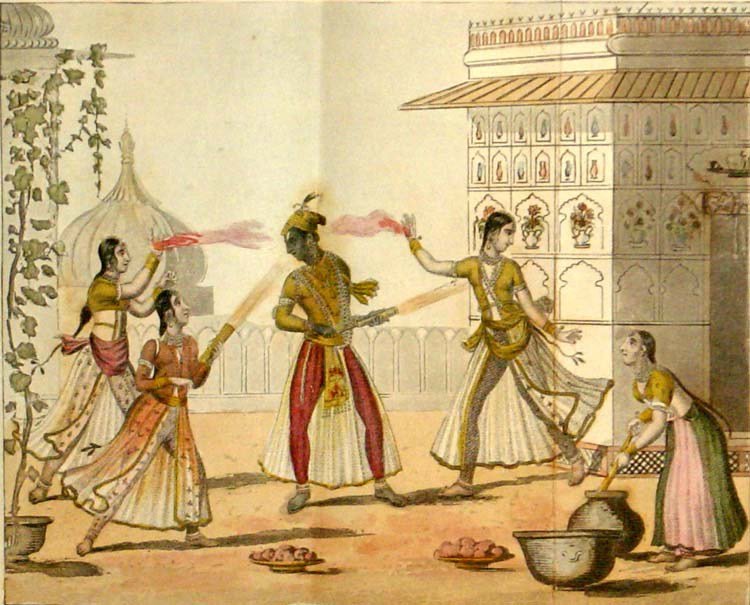This Holi drench in the sufiana colors of Daler Mehndi's sufi rendition 'Hori Khelungi' written by Baba Bullehshah

 Daler Mehndi, The celebrated Pop Star of India harkens his spiritual seeking inner self by composing befitting music and performing with similar gusto the words penned by Baba Bulleh Shah as though a seeker finds wings to his search when in communion with another on a similar path.
Daler Mehndi, The celebrated Pop Star of India harkens his spiritual seeking inner self by composing befitting music and performing with similar gusto the words penned by Baba Bulleh Shah as though a seeker finds wings to his search when in communion with another on a similar path.
Hori Khelungi Keh is a celebration by one of the undivided India's most revered philosopher, humanist, sufi poet - Baba Bulleh Shah of the late 16th century, also titled as "The man of God" , "The Knower of Spiritual Grace". Transcending cultures, faiths the author uses 'Hori' - a spring festival of colors (prominently a Hindu festival) as a metaphor. The onset of spring, hori, reference of boond (drop of water) are all metaphors for the ineffable joy being experienced by the Author as though he had caught a glimpse of the Supreme, tasted revelation which has caused more joy, more yearning, more surrender and more love.
 The song/kafi is euphoric in its expression. The author pleads with joy, affirms his supplication by advocating, like a command 'Keh Bismillah' to himself - thereafter setting an exemplary example for another seeker.
The song/kafi is euphoric in its expression. The author pleads with joy, affirms his supplication by advocating, like a command 'Keh Bismillah' to himself - thereafter setting an exemplary example for another seeker.
The song was performed live first in 2006 at the Humayun's Tomb, Jahan - e - Khusrau an event organized by the ace film maker Muzaffar Ali of the 'Umrao Jaan' fame. The song is in a Qawwali style compete with the signature Daler Mehndi energy, a panache strong enough to engulf any seeker and make a non-believer dance in celebration.
| ਹੋਰੀ ਖੇਲੂੰਗੀ ਕਹਿ ਬਿਸਮਿਲਾਹ ਨਾਮ ਨਬੀ ਕੀ ਰਤਨ ਚੜ੍ਹੀ ਬੂੰਦ ਪੜੀ ਅੱਲ੍ਹਾ ਅੱਲ੍ਹਾ, ਰੰਗ ਰੰਗੀਲੀ ਓਹੀ ਖਿਲਾਵੇ, ਜੋ ਸਿੱਖੀ ਹੋਵੇ ਫਨਾਫੀ-ਅੱਲ੍ਹਾ, ਹੋਰੀ ਖੇਲੂੰਗੀ ਕਹਿ ਬਿਸਮਿਲਾਹ । ਅਲਸਤੋਂ ਤੋਂ ਬਲਬਿਕਮ ਪ੍ਰੀਤਮ ਬੋਲੇ, ਸਭ ਸਖੀਆਂ ਨੇ ਘੁੰਘਟ ਖੋਲ੍ਹੇ, ਕਾਲੂ ਬਲਾ ਹੀ ਯੂੰ ਕਰ ਬੋਲੇ, ਲਾਇਲਾਹ ਇਲਇਲਾ, ਹੋਰੀ ਖੇਲੂੰਗੀ ਕਹਿ ਬਿਸਮਿਲਾਹ । ਨਾਹਨ ਅਕਰਬ ਕੀ ਬੰਸੀ ਬਜਾਈ, ਮਨ ਅਰਫ ਨਫਸਹੁ ਕੀ ਕੂਕ ਸੁਣਾਈ, ਫਸੁਮਾਵੱਜੁ ਉਲ੍ਹਾ ਕੀ ਧੂਮ ਮਚਾਈ, ਵਿਚ ਦਰਬਾਰ ਰਸੂਲੇ ਅੱਲ੍ਹਾ, ਹੋਰੀ ਖੇਲੂੰਗੀ ਕਹਿ ਬਿਸਮਿਲਾਹ । ਹਾਥ ਜੋੜ ਕਰ ਪਾਓਂ ਪੜੂੰਗੀ, ਆਜ਼ਿਜ਼ ਹੋ ਕਰ ਬੇਨਤੀ ਕਰੂੰਗੀ, ਝਗੜਾ ਕਰ ਭਰ ਝੋਲੀ ਲੂੰਗੀ, ਨੂਰ ਮੁਹੰਮਦ ਸੱਲਉਲਾਹ । ਹੋਰੀ ਖੇਲੂੰਗੀ ਕਹਿ ਬਿਸਮਿਲਾਹ । ਫ਼ਜ਼ਕਰੂਨੀ ਕੀ ਹੋਰੀ ਬਨਾਊਂ, ਫ਼ਜ਼ਕਰੂਨੀ ਪੀਆ ਕੋ ਰਿਝਾਊਂ, ਐਸੋ ਪੀਆ ਕੇ ਮੈਂ ਬਲ ਬਲ ਜਾਊਂ, ਕੈਸਾ ਪੀਆ ਸੁਬਹਾਨ ਅੱਲ੍ਹਾ । ਹੋਰੀ ਖੇਲੂੰਗੀ ਕਹਿ ਬਿਸਮਿਲਾਹ । ਸਿਬਗ਼ਤਉਲਾਹੈ ਕੀ ਭਰ ਪਿਚਕਾਰੀ, ਅਲਾਹ ਉਸ ਮੱਦ ਪੀ ਮੂੰਹ ਪਰ ਮਾਰੀ, ਨੂਰ ਨਬੀ ਦਾ ਹੱਕ ਸੇ ਜਾਰੀ, ਨੂਰ ਮੁਹੰਮਦ-ਸੱਲਾ ਇੱਲਾ, ਬੁੱਲ੍ਹਾ ਸ਼ਾਹ ਦੀ ਧੂਮ ਮਚੀ ਹੈ, ਲਾਇ-ਲਾ-ਇਲ ਇਲਾਹ । ਹੋਰੀ ਖੇਲੂੰਗੀ ਕਹਿ ਬਿਸਮਿਲਾਹ । |
Credits: |
An Explanation:
Hola Mohalla or Hola Mahalla or simply Hola is a Sikh festival that takes place on the first of the lunar month of Chet which usually falls in March. This, by a tradition established by Guru Gobind Singh, follows the Hindu festival of Holi by one day; Hola is the masculine form of the feminine sounding Holi.The word "Mohalla" is derived from the Arabic root hal (alighting, descending) and is a Punjabi word that implies an organized procession in the form of an army column. But unlike Holi, when people playfully sprinkle colored powder, dry or mixed in water, on each other, the Guru made Hola Mohalla an occasion for the Sikhs to demonstrate their martial skills in simulated battles.
Together the words "Hola Mohalla" stands for "mock fight". During this festival, processions are organised in the form of army type columns accompanied by war-drums and standard-bearers and proceeding to a given spot or moving in state from one gurdwara to another. The custom originated in the time of Guru Gobind Singh who held the first such mock fight event at Anandpur in February 1701.
https://www.sikhiwiki.org/index.php/Hola_Mahalla
FROM THE SPIRITUAL STANDPOINT, THE SGGS ON CELEBRATING HOLI (in part)
http://www.gurbani.org/articles/webart304.htmFrom spiritual standpoint, the SGGS tells us as to how one can go about celebrating Holi. That is, by serving Sant. Now the question is: how one can go about serving Sant? By washing their clothes? By feeding them with delicacies? By chauffeuring them around in fancy cars or flying them first-class? By building them Ashrams? By donating them money, expensive cars, planes or land? By following them blindly? By massaging their feet? By touching physical feet? None of these — according to the SGGS.
Then how is one to serve Sant (God's true Companion, Satsang, Saadh-Sangat, etc.)? As indicated in the SGGS, one is to serve Sant by the Divine Name (Naam) — ਹੋਲੀ ਕੀਨੀ ਸੰਤ ਸੇਵ. Here is the the rest of the Gur-Shabad.
- ਗੁਰੁ ਸੇਵਉ ਕਰਿ ਨਮਸਕਾਰ ॥ ਆਜੁ ਹਮਾਰੈ ਮੰਗਲਚਾਰ ॥ ਆਜੁ ਹਮਾਰੈ ਮਹਾ ਅਨੰਦ ॥ ਚਿੰਤ ਲਥੀ ਭੇਟੇ ਗੋਬਿੰਦ ॥੧॥ ਆਜੁ ਹਮਾਰੈ ਗ੍ਰਿਹਿ ਬਸੰਤ ॥ ਗੁਨ ਗਾਏ ਪ੍ਰਭ ਤੁਮ੍ ਬੇਅੰਤ ॥੧॥ ਰਹਾਉ ॥ ਆਜੁ ਹਮਾਰੈ ਬਨੇ ਫਾਗ ॥ ਪ੍ਰਭ ਸੰਗੀ ਮਿਲਿ ਖੇਲਨ ਲਾਗ ॥ ਹੋਲੀ ਕੀਨੀ ਸੰਤ ਸੇਵ ॥ ਰੰਗੁ ਲਾਗਾ ਅਤਿ ਲਾਲ ਦੇਵ ॥੨॥ ਮਨੁ ਤਨੁ ਮਉਲਿਓ ਅਤਿ ਅਨੂਪ ॥ ਸੂਕੈ ਨਾਹੀ ਛਾਵ ਧੂਪ ॥ ਸਗਲੀ ਰੂਤੀ ਹਰਿਆ ਹੋਇ ॥ ਸਦ ਬਸੰਤ ਗੁਰ ਮਿਲੇ ਦੇਵ ॥੩॥ ਬਿਰਖੁ ਜਮਿਓ ਹੈ ਪਾਰਜਾਤ ॥ ਫੂਲ ਲਗੇ ਫਲ ਰਤਨ ਭਾਂਤਿ ॥ ਤ੍ਰਿਪਤਿ ਅਘਾਨੇ ਹਰਿ ਗੁਣਹ ਗਾਇ ॥ ਜਨ ਨਾਨਕ ਹਰਿ ਹਰਿ ਹਰਿ ਧਿਆਇ ॥੪॥੧॥: Gur sevo kar namasakaar...: (Through singing His praises) I have met Gobind (God). All my worries are dispelled. Now I am in Supreme Bliss, and in happiness. (This is all because of the Guru, therefore, I) humbly bow to the Guru and serve Him. ||1|| O Lord, I sing Your Glorious Praises. (As a result) my inner house is in spring (of the Aatamic Anand) ||1||Pause|| (Because of the singing of His praises) I feel like Phalgun (Holi) within me. Joining with God's companions (Saadh-Sangat), I have begun to play (this Holi). (I) celebrate (the festival of) Holi by serving Sant. (As a consequence of Saadh-Sangat) I am imbued with the deep crimson color of the Lord's Divine Love. ||2|| (Because of the singing of His praises) my mind and body have blossomed forth, in utter, incomparable Beauty. (From my body and mind, this Aatamic Anand) does not dry out in either in sunshine (i.e., Sukha or good times) or in shade (i.e. Dukha or bad times). They always flourish (in Aatamic Anand). I have met with the Divine Guru. ||3|| (Because of the singing of His praises, it's as) the wish-fulfilling Elysian Tree has sprouted and grown (within me). It bears precious flowers and fruits of all sorts. Says Nanak, mediate on the Lord's Name. Singing the Lord's praises, (one becomes) satisfied and fulfilled ||4||1|| (sggs1180).
- ਸੰਤਾ ਕੀ ਹੋਇ ਦਾਸਰੀ ਏਹੁ ਅਚਾਰਾ ਸਿਖੁ ਰੀ ॥ ਸਗਲ ਗੁਣਾ ਗੁਣ ਊਤਮੋ ਭਰਤਾ ਦੂਰਿ ਨ ਪਿਖੁ ਰੀ ॥੧॥ ਇਹੁ ਮਨੁ ਸੁੰਦਰਿ ਆਪਣਾ ਹਰਿ ਨਾਮਿ ਮਜੀਠੈ ਰੰਗਿ ਰੀ ॥ ਤਿਆਗਿ ਸਿਆਣਪ ਚਾਤੁਰੀ ਤੂੰ ਜਾਣੁ ਗੁਪਾਲਹਿ ਸੰਗਿ ਰੀ ॥੧॥ ਰਹਾਉ ॥: Santaa kee hoi daasaree ehu achaaraa sikhu ree ... (sggs 400).
http://www.gurbani.org/articles/webart304.htm
[Holi through the years gone by - ED]
Kheloongi Holi ( I shall play Holi)
https://thinkloud65.wordpress.com/2013/03/24/
Phagwa, more commonly known as Holi, celebrated on the full moon day of Phalgun, is a festival that heralds the arrival of spring. Played with dry and wet color, it is a symbolic expression for the changing temperatures and the blossoming fields.
Since very young, on the morning of Holi, I saw my Muslim parents being called at the gates of our house in Delhi, by a group of faces immersed in colors, who all looked almost identical. As my parents walked out, they were enthusiastically smeared with color by the crowd, and they too lost their identity with crowd. It left no clue as to who was who, when they roared together with laughter and excitement. As we siblings grew up, we joined in too, with our set of friends.
Holi, as I envision it, is a perfect way to depict a spirit of universal brotherhood beyond color, creed, caste or social status.
If taken in it’s true spirits, Holi never was and never is meant to be a religious festival to be celebrated by a select faith.
Though, like other religious festivals, it too claims a legend with a victory of the good over the evil ( The Story of Holika). However, from the context of its current celebration, it is said to have begun by the love duo Krishna and Radha
Krishna as a young boy, being extremely dark complexioned, complained to his mother Yashoda, why was he dark, while his beloved Radha fair?
The conversation between a complaining son, and his doting mother, is narrated beautifully, in a famous folk song:
Yashomati mayya sey bole Nand Lala,
Radha kyun gori, main kyun kala?
Boli muskaati Mayya, Sun merey pyaare,
Gori gori Radhika ke, nain kajrare,
Kaale nainon waali ney, aisa jadu dala,
Tuu isee liye kaala.
(Krishna asks mother Yashoda: “Why am I dark, while Radha is so fair?” Mother smiles and replies: “Listen my dear, the fair Radha’s kohl eyes have swept you with their magic, and hence are you so dark.)
And one day teasingly to console Krishna she is said to have told him: “What’s in a color? Go and smear Radha’s face with any color you like.” And Krishna out of love for Radha, smeared her with red color( gulaal).
Legend claims that thus began the playing of colors ( Holi khelna), between Krishna and Radha along with her friends referred to as Gopis.
Their romance with playing Holi has been immortalized in many miniature painting

Another one, with in Mughal art:

Mughal Emperors too fancied Holi, for its association with color and romance. They brought the practice of playing Holi to their courts and palaces.
Akber is no surprise, knowing his secular conviction and a Hindu Queen, Joda Bai.
Jehangir, the romantic art connoisseur, is documented to have played Holi with his Queen Noor Jehan in his palace and called it Eid-e-Gulabi. It isnt hard to imagine the ecstatic aroma and aura that must have been created in the palace by red gulaal, rose petals ( gulab paashi) and rose water (aab paashi) being sprinkled during the royal play.
Auranzeb’s fancy for the colors of Holi came as a surprise to me. Writes Lane Poole in biography Auranzeb: “During his time there used to be several groups of Holi singers who besides reciting libertine lyrics also indulged in salaciousness, accompanied by various musical instruments.”
Bahadur Shah Zafar’s verses on Holi now are sung as part of the phaag ( folk songs of Holi). One of the most sung verses being:
Kyo Mo Pe Rang Ki Maari Pichkaari
Dekho Kunwar Ji Doongi Mein Gaari
(Why drench me with color spray,
now my prince, I will swear at you)
Bahut Dinan Mein Haath Lage Ho Kaise Jane Doon Aaj Phagwa To Son Ka Tha Peeth Pakad Kar Loon. (After long have you come in my hands, how will I let you go? Today is Holi, and perfect time to catch hold of you)
This is Mughal Emperor Jehangir playing Holi in his palace:

Sufi poets too eulogized the Radha Krishna romance and Holi, when expressing their love for their revered Sufi Saints or even God.
To begin with Sufi poets, it is Shah Niaz’s ‘s Hori Ho Rahi hai, (immortalized by Abida Parveen):
Holi hoye rahi hai Ahmad Jiya ke dwaar
Hazrat Ali ka rang bano hai Hassan Hussain khilaar
Aiso holi ki dhoom machi hai chahoon or pari hai pukaar
Aiso anokho chatur khiladi rang deeyon sansaar
“Niaz” pyaara bhar bhar chidke ek hi raang sahas pichkaar.
(Holi is happening at beloved, Ahmed’s (saww) doorsteps.
Color has become of Hazrat Ali (as) and Hasan (as), Hussain (as) are playing.
It has become such a bustling scene of Holi that it has become talk of the town,
people are calling others from all over,
What unique and clever players (Hasan and Hussain) that they colored the entire world.
Niaz (the poet) sprinkles bowlfuls of color all around,
the same color that comes out of thousands of pichkaaris ( spray guns).)
{Thanks to Ali Rehman @Baahirezaman for the translation}.
Bulleh Shah also played Holi with his Master:
Hori khailoongi keh Bismillah
Naam nabi ki rattan charhi, bond pari Illalah
Rang rangeli ohi khilawe, jo sakhi howe fana fi Allah(I shall play Holi, beginning with the name of Allah. The name of Prophet is enveloped with light, He only makes us play with colors, who annihilates with Allah)
Amir Khusro relates to Holi through multiple fascinating ways, in various places. Khusrau refers not just to the color, or the play but of the birth place of Krishna Mathura in the famous Aaj Rung hai rey:
Gokal dekha, Mathra dekha,
par tosa na koi rang dekha
Ey main dhoond phiri hoon
Des bides mein dhoond phiri hoon,
Purab dekha pacham dekha
uttar dekha dakkan dekha
Re main dhoond phiri hoon
Des bides mein dhoond phiri hoon,
Tora rang man bhaayo Moinuddin
Mohe apne hi rang mein rang le Khwaja ji
Mohe rang basanti rang de Khwaja Ji
Mohe apne hi rang mein rang de
{In summary: I saw Gokul, Mathura ( bith place of Krishna) and even East to West I roamed, but I did not find anyone with a color like yours. My heart is enamored by your color, hence color me in your shade, my master.}
Another lesser know verse I came across is:
Khelooongi Holi, Khaaja ghar aaye, Dhan dhan bhaag hamarey sajni, Khaaja aaye aangan merey.. ( I shall play Holi as Khaaja has come to my home, Blessed is my fortune, O’ friend, as Khaaja has come to my courtyard.)
Needless to repeat, there are ample such examples. No matter how much one may attempt, it is impossible to separate the two inter-meshed cultures coexistent for centuries in the subcontinent. These celebrations of culture are all about love and inclusion, and absolutely nothing about hate and discrimination.
Let’s celebrate then, with an open heart !
Here is the link to Amir Khusrau’s Kheloongi Holi, Khaaja ghar aaye: https://www.youtube.com/watch?v=owFCPKI9k2A
